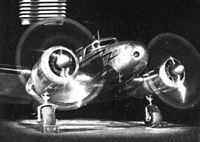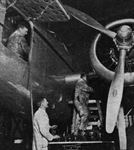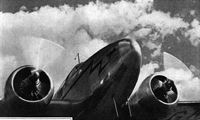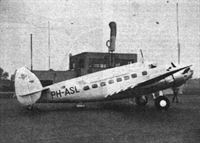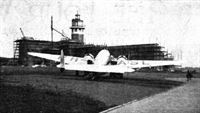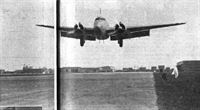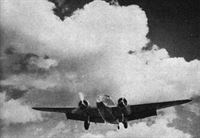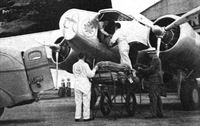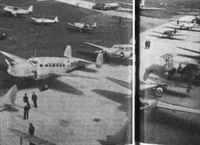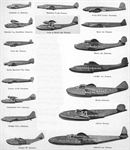
Super Electra 14
Lockheed 14 Super Electra
Самолет Lockheed 14 Super Electra проиграл конкурентам Douglas DST/DC-2/DC-3 из-за меньшей пассажировместимости. Новая модель, сохранив компоновку предшествующей, отличалась фюзеляжем большего объема, допускавшим размещение 14 пассажиров, и среднерасположенным крылом с топливными баками-кессонами и закрылками Фаулера. Конструктивные улучшения в сочетании с моторами большей мощности и увеличенной нагрузкой на крыло обеспечили Super Electra отменные летные данные.
Но более крупный DC-3 превзошел самолет "Lockheed" по экономической эффективности. Построили всего лишь 112 машин Lockheed 14. Прототип Lockheed 14 впервые поднялся в воздух 29 июля 1937 года, самолет был сертифицирован 15 ноября 1937 года. Вскоре начались поставки серийных машин заказчикам. Большинство Super Electra ушли на экспорт. 119 самолетов построено по лицензии в Японии для Императорской армии. Японский вариант оснащался моторами Mitsubishi Ha-26-1 в 900 л. с. и обозначался Army Type LO Transport, союзники во время войны присвоили ему наименование "Thelma".
Варианты
Lockheed 14-H и 14-H2: исходные серийные варианты с моторами Hornet S1E-G или S1E2-G соответственно
C-14H-1: обозначение одного 14-H, переоборудованного в транспортный вариант; позже самолет переоборудовали обратно в 14-H
Lockheed 14-08: переоснащенные моторами Twin Wasp S1C3-G 14-H2 компании "Trans-Canada Air Lines"
Lockheed 14-WF62 или 14-F62: экспортный вариант с моторами Wright SGR-1820-F62 Cyclone мощностью 900 л. с.
Lockheed 14-WG3B: экспортный вариант с моторами Wright GR-1820-G3B мощностью 900 л. с.
Lockheed 14-N: четыре самолета, построенные согласно требованиям частных заказчиков
C-111: обозначение трех 14-F62 в ВВС Армии США, предназначенных для эксплуатации в Австралии
XR40-1: обозначение одного 14-H2 в ВМС США, использовался для перевозки штабных офицеров
ТАКТИКО-ТЕХНИЧЕСКИЕ ХАРАКТЕРИСТИКИ
Lockheed 14-H Super Electra
Тип: пассажирский ближне-/среднемагистральный самолет
Силовая установка: два звездообразных мотора Pratt & Whitney Hornet S1E-G мощностью по 875 л. с. (652 кВт)
Летные характеристики: максимальная скорость 398 км/ч на высоте 2135 м; практический потолок 7405 м; максимальная дальность 3315 км
Масса: пустого 4672 кг; максимальная взлетная 7938 кг
Размеры: размах крыла 19,96 м; длина 13,51 м; высота 3,48 м; площадь крыла 51,19 м2
- Super Electra 14
Фотографии
-
Мир Авиации 1995-02 / М.Маслов - Гонки над Россией /Перелеты/
Регистрационный номер: NX18973 [4] Lockheed Super Electra. Перелет Г.Хьюза, июль 1938г.
-
Авиация и Космонавтика 2024-09 / В.Морозов - Военная авиация Польши 1918-2024гг. (3)
Регистрационный номер: G-AFKE [2] Варшавский аэропорт Окенче летом 1938 г. На переднем плане слева Ju-52/3m авиакомпании «LOT», позади него - Локхид «Электра» английской «Бритиш Эруэйз».
-
Jane's All the World Aircraft 1938 / 03 - All the world's aeroplanes
Регистрационный номер: NC18971 The Lockheed 14 Twelve-passenger Commercial Transport (two 750 h.p. Pratt & Whitney "Hornet" engine).
-
Flight 1937-10 / Flight
TEST FLIGHT: The first of the new Lockheed "14s" photographed on its first flight. Apparently the machine has come up to, or even exceeded, its estimated performance figures, though it is rumoured that the Fowler flap gear demands a new approach technique. K.L.M. are the first European transport firm to place orders for this type which has an estimated cruising speed of about 240 m.p.h. depending on the particular engines installed - whether Cyclones or Hornets.
-
Flight 1939-05 / Flight Advertisements
COMING IN: The machine shown about to land with flaps and wheels lowered is Lockheed 14. Particularly noteworthy are the Fowler flaps on the Lockheed 14, which has a maximum speed in the neighbourhood of 260 m.p.h. and is fitted with two Wright Cyclone engines.
-
Flight 1937-08 / Flight
FOWLER-FLAPPED: The first photographs of the new Lockheed 14, or Super-Electra, transport. It will be noted that although this machine bears the "X" licence markings it carries the insignia of Northwest Airlines. Points of technical interest include the Fowler flaps, the shape of the fuselage (in particular the nose) and the tail unit, the latter of a type which has given such encouraging results on the Electra and "12."
-
Aviation Historian 16 / N.Mathisrud - The Other Stockholm Run
Регистрационный номер: G-AFMO [8] Lockheed 14WF62 Super Electra G-AFMO (c/n 1490) parked near the Airwork hangar at Heston in April 1939. This aircraft was used by British Airways on the Scandinavian Express - Flight 730 - between Whitchurch and Helsinki via Stavanger and Stockholm the same year, but was destroyed in a landing accident at Heston in January 1940.
-
Flight 1939-06 / Flight Advertisements
SEVEN-FIFTY FROM PARIS: An attractive photographic effect of floodlights on a British Airways Electra, which had just completed the last of the day’s six journeys to and from Le Bourget. The company will very shortly be taking delivery of the first of its Lockheed 14s.
-
Flight 1938-10 / Flight
Регистрационный номер: G-AFGN [8] THE HARBINGER: A fine study of the British Airways Lockheed 14 in which the Prime Minister made his second historic flight to Germany.
-
Aeroplane Monthly 1974-11 / P.Moss - British Airways (2)
Регистрационный номер: G-AFGN [8] Lockheed 14 G-AFGN, the actual aircraft used by Neville Chamberlain for the Hitler appeasement flights to Munich and Godesburg.
-
Flight 1938-12 / Flight Advertisements
Регистрационный номер: G-AFGN [8] -
Aeroplane Monthly 1993-08 / Personal album. Civil
Регистрационный номер: G-AFKE [2] Lockheed L.14-F62 Super Electra G-AFKE of British Airways at Budaors, Budapest, during 1939.
-
Flight 1938-09 / Flight
Регистрационный номер: G-AFGN [8] ONE OF FOUR: Airwork and general interest in British Airways' first Lockheed 14, which was flown up to Heston from Southampton, where it was assembled, last Saturday. The cleanliness of the Hamilton hydromatic airscrew hubs is noteworthy. The British Airways’ 14s have several non-standard features.
-
Flight 1939-06 / Flight
Hydraulic services and various vacuum-operated instruments are checked in situ with the aid of a portable pressure and vacuum unit.
-
Flight 1938-10 / Flight
British Airways Fourteens are the first British machines to be fitted with the new Marconi streamlined D.F. aerial, the casing of which will be seen just aft of the fixed aerial support. The “rails,” which may just be discerned under the fuselage between the undercarriage legs, are part of the blind-approach aerial system.
-
Flight 1939-05 / Flight
The Lockheed Fourteen at Heston on April 17. The Fowler flaps are in the half-way position, while the "letter-box" slots may just be seen near the wins tip.
-
Air Enthusiast 2000-11 / G.Warner - Founding Fathers (2)
Регистрационный номер: G-AFGN [8] British Airways Lockheed 14 Super Electra G-AFGN carried Neville Chamberlain on what might now be described as the first piece of 'shuttle diplomacy'.
This aircraft caught fire in mid-air and made a casualty-free crash landing in France in August 1939. -
Air-Britain Archive 1984-04
Регистрационный номер: G-AFGN [8] British Airways' G-AFGN arriving at Heston at the end of the first non-stop service from Stockholm on 18.9.38.
-
Flight 1938-09 / Flight
Регистрационный номер: G-AFGN [8] NON-STOP "FOURTEEN": British Airways’ Lockheed 14, which flew from Heston to Stockholm and back last Sunday, having made the 905-mile journey non-stop each way. On the outward trip she averaged 212 m.p.h.
-
Aeroplane Monthly 1974-11 / P.Moss - British Airways (2)
Регистрационный номер: G-AFMO [8] G-AFMO was badly damaged when it overshot while landing at Heston in January 1940.
-
Aeroplane Monthly 1974-11 / P.Moss - British Airways (2)
Регистрационный номер: G-AFGP [2] Lockheed 14-WF62 G-AFGP.
-
Air Enthusiast 1994-09 / A.Wood - Airline at War
The crew for the Helsinki flight pose in front of their aircraft at Heston, September 1939: left to right Captain D S King, F/O J W S Beach, R/O J W Elliott, F/Clerk B R Bryan and F/E Bonici.
-
Flight 1939-05 / Flight
WHEN Col. Smallwood (seen here) went to Poland to lecture to Anglo-Polish societies, he travelled by the inaugural British Airways service from London to Warsaw.
-
Air Enthusiast 1994-09 / A.Wood - Airline at War
Регистрационный номер: G-AFMR Lt Col Sir Francis Shelmerdine, Director General of Civil Aviation, addresses the crowd in front of British Airways Lockheed 14-WF62 G-AFMR at Heston, prior to the inaugural flight to Warsaw, April 17,1939.
-
Aeroplane Monthly 1989-03 / Personal album. Civil
Регистрационный номер: G-AKPD The ill-fated Lockheed Model 14-H G-AKPD, photographed in October 1948. This may well have been the last photograph taken of it in one piece, for it left shortly after en route to Australia. Within hours it was reported missing. During the deep sea search for the remains of the D.H.106 Comet remains off Elba, the barnacle-encrusted fuselage of the Lockheed was recovered.
-
Flight 1939-04 / Flight
Регистрационный номер: G-AFMO [8] BUDAPEST-BOUND: A Lockheed Fourteen taxying out to take off for the first Frankfurt-Budapest run. Notice the fixed “letter-box” slots near the wing tip and Heston’s major obstruction - the Southall gasholder.
-
Aeroplane Monthly 1974-11 / P.Moss - British Airways (2)
Регистрационный номер: G-AFMO [8] -
Air Enthusiast 1994-09 / A.Wood - Airline at War
Регистрационный номер: G-AFMO [8] Electra G-AEPN undergoing maintenance in the British Airways hangar at Heston. In the background are four Lockheed 14-WF62s, including G-AFMO which was destroyed in a crash-landing at Heston on January 15,1940.
Другие самолёты на фотографии: Lockheed Electra 10 - США - 1934
-
Flight 1938-03 / Flight
Регистрационный номер: PJ-AIP CYCLONE-POWERED “FOURTEEN”: The first Lockheed 14 transport for the Royal Dutch Air Lines. This model has Wright Cyclone G engines (850/1,000 h.p.) which, it is estimated, should give it a top speed of over 265 m.p.h. Machines of this type will be used on K.L.M.’s West Indian services, and this particular 14 has recently been flown to Curasao by Cdr. Geisendorfler.
-
Мировая Авиация 174
Регистрационный номер: PH-APE [3] Lockheed 14-F62 "Ekster" голландской компании KLM. Авиакомпания KLM закупила шесть Lockheed 14, а ее дальневосточный филиал KNILM - пять.
-
Aeroplane Monthly 1976-03 / Personal album
Регистрационный номер: PH-APE [3] KLM introduced the Lockheed 14 to their European network in 1938. With the arrival of PH- APE Ekster at Doncaster it marked the first visit of an aircraft fitted with Fowler type area-increasing flaps. Ekster was not fitted with wing tip slots, and the type was prone to spectacular wing drops during round-out - it was this characteristic which led to Ekster’s loss on a training flight.
-
Flight 1938-08 / Flight
Регистрационный номер: PH-ASL [3] Three-Fifty-Five (Amsterdam time): The Lockheed 14 ready to load up for the Liverpool run. The signboard on the right tells both passengers and public all about it.
-
Flight 1938-08 / Flight
Регистрационный номер: PH-ASL [3] Fifteen minutes at Doncaster: The Lockheed in front of the control building, on which the D.F. loop may be seen. When this photograph was taken the last was not being a great deal of use since the whole district was suffering from a series of violent thunderstorms.
-
Flight 1938-08 / Flight
Регистрационный номер: PH-ASL [3] TERMINAL: A K.L.M. Lockheed 14 Refuelling at the back of the shortly-to-be-completed airport building at Speke, Liverpool. For a long time the control tower stood alone in its glory; the rest of the building now begins to give it true perspective.
-
Flight 1938-12 / Flight
The vast area of the Fowler type of flap is admirably shown in this photograph of a Lockheed 14 coming in to land.
-
Flight 1938-08 / Flight
The photograph of the Lockheed coming in to land on one of Schiphol’s runways, which are now being further extended, gives a good idea of the area presented by the Fowler flaps. The cleanliness of the retractable undercarriage is noteworthy.
-
Flight 1939-02 / Flight
Регистрационный номер: PJ-AIT [3] K.L.M. IN THE WEST INDIES: Hato aerodrome, Curasao, with two K.L.M. Lockheed 14s and one of the Fokker F.18s which have been used by the company since the services started after the first F.18 had been flown across the South Atlantic.
Другие самолёты на фотографии: Fokker F.IX / F.XII / F.XVIII - Нидерланды - 1929
-
Flight 1939-04 / Flight
Регистрационный номер: PJ-AIT [3] K.L.M. run a number of useful services in the West Indies: This photograph shows one of their Lockheed 14s being refuelled at Barranquilla, in Colombia. S.C.A.D.T.A. is that country’s own operating company and the name will be seen on the terminal building behind the tail of the 14.
-
Мировая Авиация 165
Регистрационный номер: PJ-AIT [3] Компания KLM была верным потребителем самолетов "Lockheed" и использовала Model 14 на дальней авиалинии между Амстердамом и Батавией в Голландской Ост-Индии.
-
Flight 1939-04 / Flight Advertisements
Регистрационный номер: F-ARIU -
Flight 1938-07 / Flight
The Lockheed 14 over New York. (Left) Mr. Howard Hughes.
-
Flight 1938-11 / Flight
TRANS-CANADA: Last month the Trans-Canada Air Lines service was officially extended to cover the section between Montreal and Winnipeg. In this set of pictures there are three views of one of the ten Lockheed Fourteens which are now, with five Electras, in service, and two pictures of typical Canadian terrain. Here, are the San Juan Islands near Vancouver
-
Flight 1938-11 / Flight
A view of the Coast Range, near Seattle
-
Flight 1939-07 / Flight Advertisements
Регистрационный номер: CF-TCH On April 1, 1939, Trans-Canada Air Lines added a daily passenger schedule to its established airmail service from Montreal to Vancouver. Within a few weeks six more luxurious Lockheed 14 transports were ordered. This will bring Trans-Canada’s total Lockheed fleet to twenty.
-
Flight 1938-11 / Flight
One of the T.C.A.L. Fourteens is shown coming in to land with the large-area Fowler flaps in the down position.
-
Flight 1938-11 / Flight
Another scene at Winnipeg, with a Fourteen being refuelled. The transparent nose, enclosing the D/F loop, is an interesting feature. Without such an arrangement it would be necessary for this loop to be outside the fuselage, which is otherwise metal-covered.
-
Flight 1939-04 / Flight
At the Trans-Canada Air Lines’ operational base at Winnipeg, with two of the company’s Lockheed 14s on the tarmac.
-
Flight 1939-08 / Flight
CANADIAN TERMINUS: Sea Island Airport, Vancouver, B.C., with one of Trans-Canada Air Lines' Lockheed Fourteens and one of United Air Lines’ old Boeing 247 Ds on the tarmac.
Другие самолёты на фотографии: Boeing Model 247 - США - 1933
-
Flight 1939-07 / Flight Advertisements
SERVICING T.C.A. LOCKHEED 14 - Easy access to control units is an important maintenance advantage...speeds up the frequent, routine inspections.
-
Flight 1939-07 / Flight Advertisements
LOADING T.C.A. LOCKHEED 14 - Four spacious cargo compartments accommodate airmail and express traffic between Vancouver and Montreal...2411 miles, now covered in 14 flying hours.
-
Flight 1938-11 / Flight
TRANS-CANADA: Last month the Trans-Canada Air Lines service was officially extended to cover the section between Montreal and Winnipeg. In this set of pictures there are three views of one of the ten Lockheed Fourteens which are now, with five Electras, in service, and two pictures of typical Canadian terrain. Here is a Fourteen taking on mails at the Winnipeg terminal.
-
Авиация и Космонавтика 2024-09 / В.Морозов - Военная авиация Польши 1918-2024гг. (3)
Регистрационный номер: SP-BNF Локхид 14 «Супер Электра» авиакомпании «LOT». 1938-1939 гг.
-
Авиация и Время 2013-02 / А.Степанов - Весна 1940. Несостоявшийся "Южный вариант"
Пассажирский самолет Локхид "Супер Электра" британцы использовали в качестве разведчика.
-
Jane's All the World Aircraft 1938 / 03 - All the world's aeroplanes
The Lockheed 14 Twelve-passenger Commercial Transport (two 750 h.p. Pratt & Whitney "Hornet" engine).
-
Aeroplane Monthly 1999-05 / J.Underwood - Tachikawa album /1930s-1940s japanese/
The Tachikawa Aeroplane Co Ltd, successors to the Ishikawajima company in 1936, continued the production of light aircraft, notably the Army Type 95. Shown here is the TS-1 ultralight single-seater of 1937 and the licence-built Lockheed 14WG3, 64 of which were built by Tachikawa during the period 1939-42.
Другие самолёты на фотографии: Tachikawa TS-1 - Япония - 1937
-
АвиаМастер 2003-05 / М.Маслов - "Москва" на Гудзоне /Покорение неба/
Самолет Локхид L-14 "Супер Электра", на котором Коккинаки и Гордиенко вылетели из Монктона в Нью-Йорк. Виден фрагмент бортовой надписи на русском языке "...привет".
-
Мир Авиации 1995-02 / М.Маслов - Гонки над Россией /Перелеты/
Регистрационный номер: NX18973 [4] Lockheed Electra Говарда Хьюза в Москве, 1938г.
-
Мировая Авиация 83
Регистрационный номер: NX18973 [4] 14 июля 1938г.: американский магнат Г. Хьюз приземлился на своем Lockheed 14N во Флойд Беннет Филде, облетев Северное полушарие за 3 дня, 19 ч и 8 мин - почти на четыре дня лучше прежнего рекорда У. Поста.
-
Мировая Авиация 165
Регистрационный номер: NX18973 [4] Встреча самолета Говарда Хьюза Model 14-N на нью-йоркском аэродроме Флойд Беннет Филд после завершения кругосветного перелета, 1938 год. Входе него были сделаны остановки в Париже, Москве, Омске, Якутске, Фэрбенксе (Аляска) и Миннеаполисе.
-
Flight 1938-01 / Flight
Air Corps officials inspecting the Fowler flaps on the Lockheed 14 (or Sky Zephyr) transport.
-
Air Pictorial 1957-10 / Air Pictorial's photo-review
Регистрационный номер: CF-TCO Another EM "bird'' carrier is the Kenting Aviation's Lockheed Model 14-08 (c/n. 1500; CF-TCO) ex-TCA.
-
Flight 1938-05 / Flight
A few of the visiting machines on the tarmac at Helsingfors Airport last Sunday. The machine on the left is the L.O.T. Lockheed 14, while in the foreground, just to be seen, is one of the Aero O/Y two Rapides.
Другие самолёты на фотографии: De Havilland Dragon Rapide / Dominie / D.H.89 - Великобритания - 1934
-
Air Enthusiast 1996-11 / K.Wixey - Incidental Combatant (1)
Регистрационный номер: PH-APE [3] Ramp scene at Amsterdam-Schiphol June 25, 1938, dominated by Fw 200 V2 D-AETA ‘ Westfalen ’ of DLH. Alongside it is Fokker-assembled Douglas DC-3 PH-ARZ ‘Ijsvogel' of KLM. To the left is Curtiss T-32 Condor G-AEZE of International Air Freight and to its right KLM Lockheed Super Electra PH-APE ‘Ekster’.
Другие самолёты на фотографии: Curtiss Condor 18 - США - 1929Douglas DC-3 / C-47 Skytrain/С-53 Skytrooper / Dakota - США - 1935Focke-Wulf FW.200 Condor - Германия - 1937
-
Air Enthusiast 1996-09 / M.Axworthy - Flank Guard. Romania's Aerial Advance on Stalingrad (2)
Three ex-LOT Lockheed 14 Super Electras nearer the camera, and three Lockheed 10A Electras in the distance. This photograph is thought to be of the commissioning ceremony of the ‘Escadrila’ LARES in June 1941.
Другие самолёты на фотографии: Lockheed Electra 10 - США - 1934
-
Aeroplane Monthly 1981-07 / Whitchurch /Gone but not forgotten/ (10)
Armstrong Whitworth Ensigns, 2 Lockheed 14 and a D.H.95 Flamingo at Whitchurch during the early part of the last war.
Другие самолёты на фотографии: Armstrong Whitworth Ensign / A.W.27 - Великобритания - 1938De Havilland Flamingo / D.H.95 - Великобритания - 1938
-
Flight 1939-03 / Flight
Регистрационный номер: NX18962 [2] To meet the requirements of the U.S. Army Air Corps a special version of the Lockheed 14 has been developed as a military transport. The hump on the fuselage is a characteristic feature.
-
Flight 1939-05 / Flight Advertisements
Регистрационный номер: NX18962 [2] -
Flight 1938-08 / Flight
Inside the control cabin of the Fourteen: The main control bank appears to be more complicated than it really is in practice. At its base, with appropriate indicators, can be seen the tab trimmer cranks for the elevators, rudder and ailerons, with the pull-type brake lever in the centre. Above are the engine, airscrew, heater, boost and automatic pilot controls. The flying instruments are on the left of the Sperry panel, and the temperature and fuel gauges on the right. At the top of the board will be seen the boost gauges (all-important nowadays) and the two-needle revolution indicators.
-
Flight 1938-10 / Flight
The “works” in one of British Airways new Lockheed Fourteens. It will be seen that the standard layout has been modified to incorporate a special compartment for the radio operator, and in this sketch the bulkhead dividing this compartment from that used by the passengers is cut away on the right to show the position of the different features of the extensive radio equipment. This includes not only a blind approach receiver and medium-wave sets, but also short - wave equipment, since the Fourteens will eventually be used for long-distance work on the West African service.
-
Flight 1938-11 / Flight
Marconi radio in a British Airways Lockheed Electra. On the left is the short-wave receiver, and on the right the medium-wave and D.F. receiver, with remote control for the external loop.
-
Flight 1938-08 / Flight
Inside the cabin of one of the K.L.M. Lockheeds. The radio operator is seated in front on the right; part of his equipment may be seen. British Airways’ Fourteens will have a separate compartment for the operator. The passengers’ seats are normally adjustable and may also be turned.
-
Air-Britain Archive 1984-04
Регистрационный номер: G-AFGP [2] A wartime accident to G-AFGP, by this time absorbed into the BOAC fleet and wearing British nationality stripes. The print is undated but may show the crash at Khartoum on 4.8.41.
-
Air-Britain Archive 1984-03
Регистрационный номер: G-AFMO [8] Lockheed 14-WF62 c/n 1490 written off in a crash landing at Heston on 15.1.40.
-
Air Enthusiast 1994-09 / A.Wood - Airline at War
Регистрационный номер: G-AFMO [8] The Author’s photograph of the demise of Lockheed 14 G-AFMO, at Heston on January 15, 1940. A miraculous escape.
-
Air Enthusiast 1994-09 / A.Wood - Airline at War
Регистрационный номер: G-AFMO [8] Another view of the wreckage pattern of G-AFMO.
-
Aeroplane Monthly 1981-07 / Painted Wings
Регистрационный номер: G-AFGN [8] Claude Waller's study of the "Chamberlain" Lockheed 14, G-AFGN, over Heston.
-
Flight 1938-04 / Flight
PLOUGHSHARE AND SWORD: Civil and military versions of the Lockheed 14 monoplane, sometimes called the Zephyr. The transport machine does over 260 m.p.h. with two Cyclone Gs; turrets will detract from the performance. The bomb stowage is interesting, an advantage being that only a comparatively small hole has to be cut in the skin covering of the fuselage for the bombs to <...>
-
Flight 1938-06 / Flight
A hypothetical military version of the Lockheed 14 with three guns and a heavy bomb load.
-
Flight 1938-10 / Flight
Details of the operation of the Fowler flaps on the Fourteen. It will be seen how, with the use of a single operating cable and a special track or guide, the flap is arranged to move through different positions. Three of these positions are shown diagrammatically on the right.
-
Flight 1938-04 / Flight
Другие самолёты на фотографии: Bloch MB.160 Languedoc - Франция - 1937Boeing Boeing 314 Clipper - США - 1938Consolidated PBY Catalina - США - 1935Dewoitine D.332 / D.333 / D.338 / D.620 - Франция - 1933Douglas DC-3 / C-47 Skytrain/С-53 Skytrooper / Dakota - США - 1935Douglas DF - США - 1936Focke-Wulf FW.200 Condor - Германия - 1937Junkers Ju.86 - Германия - 1934Latecoere Late 631 - Франция - 1942Liore et Olivier LeO H.246 - Франция - 1937Martin Russian Clipper / Type 156 - США - 1937Potez Potez 661 - Франция - 1937Potez-CAMS Potez-CAMS 160 / 161 - Франция - 1938Savoia-Marchetti / SIAI SM.83 - Италия - 1937Sikorsky S-43 Baby Clipper/JRS/Y1OA-8 - США - 1936Sud-Est SE.200 - Франция - 1943
- Фотографии








